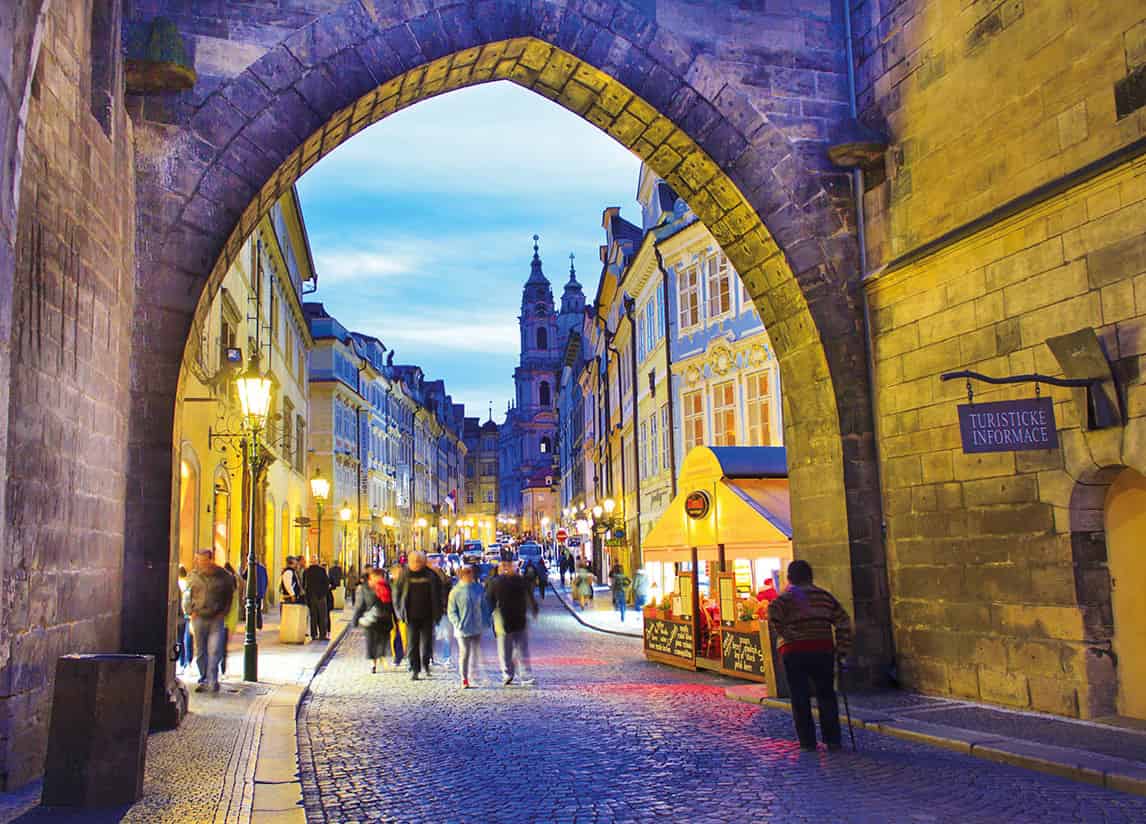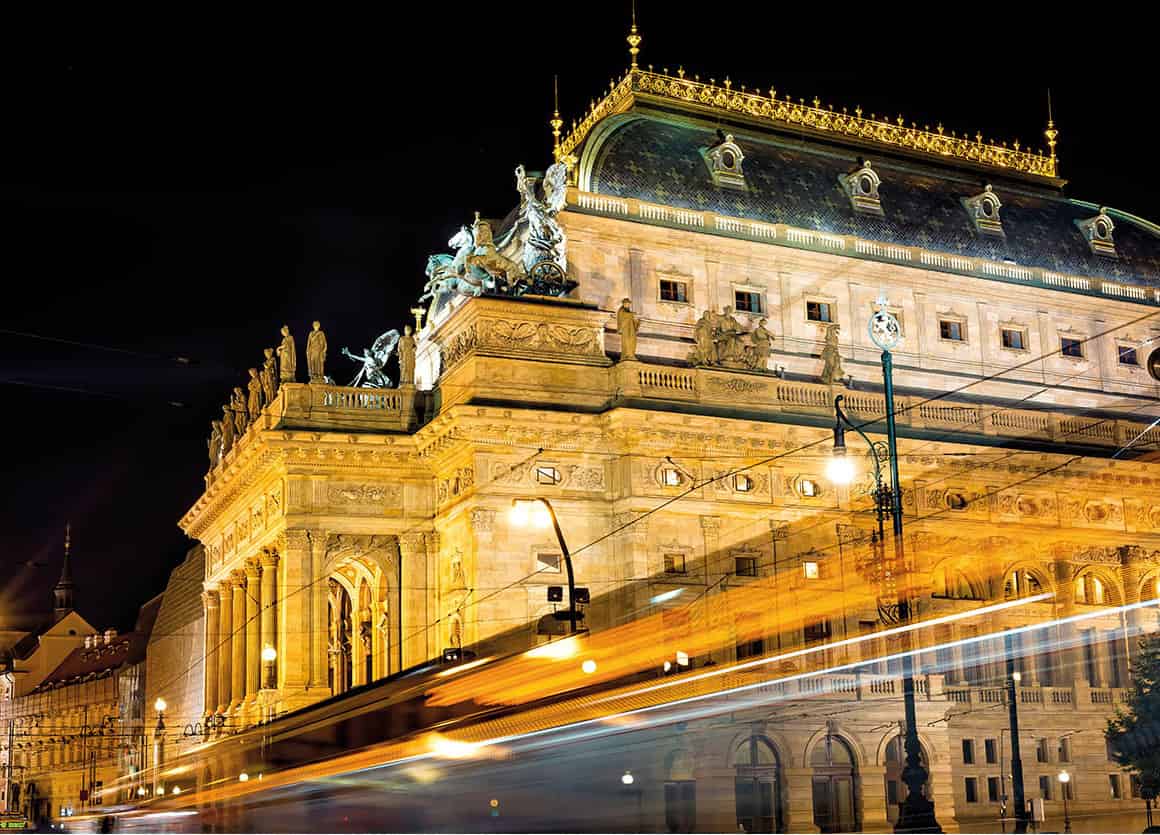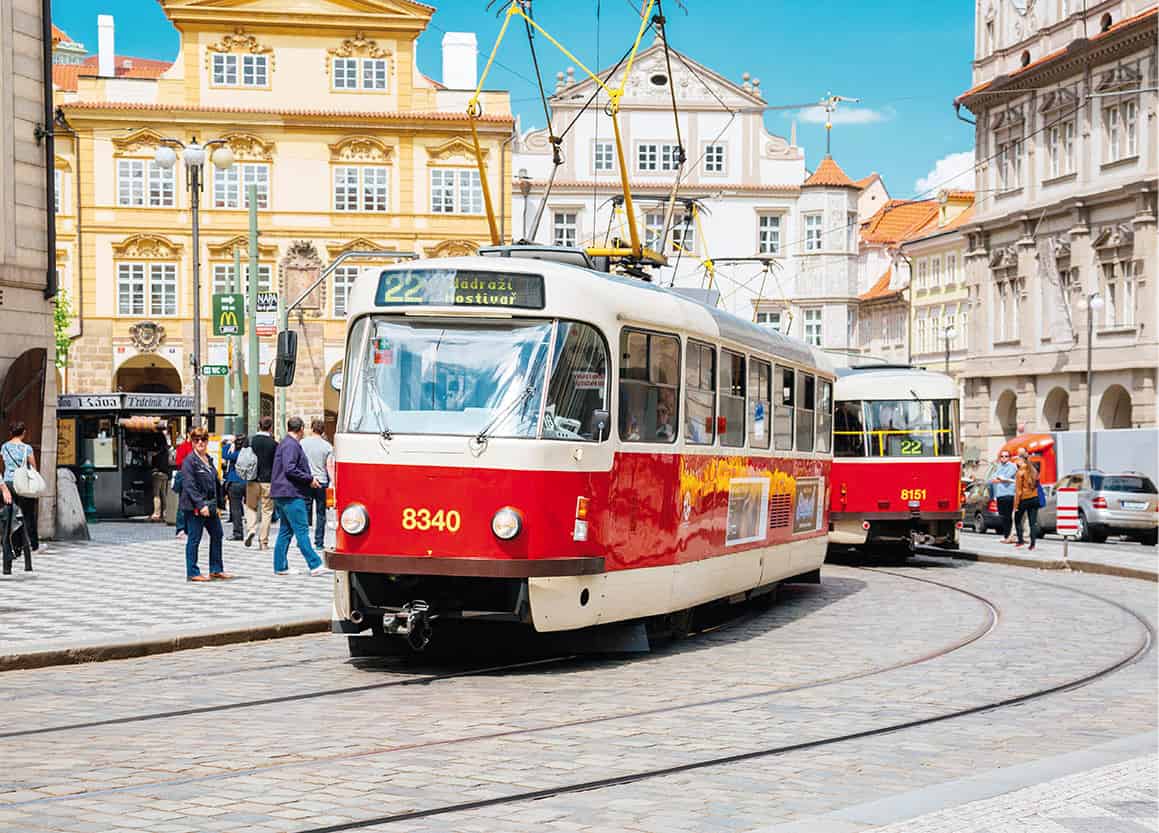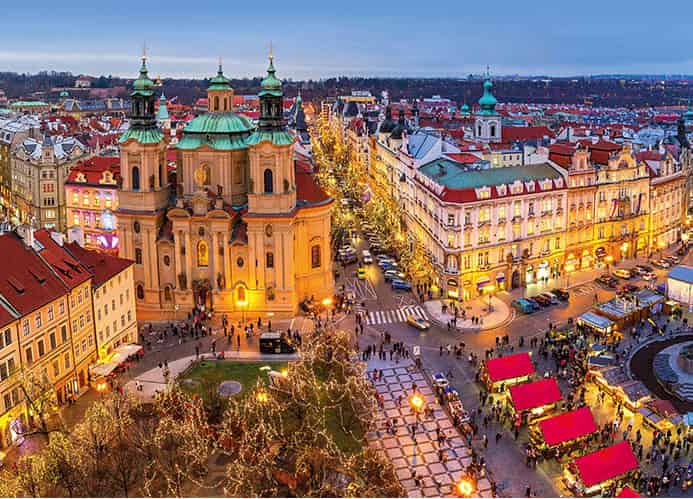Located at the heart of Europe, Prague (‘Praha’ in Czech) has been the capital of the ancient realm of Bohemia for centuries. During the Middle Ages it rose to prominence as the capital of Charles IV’s vast empire. As Holy Roman Emperor and ruler of much of Western Europe, he was probably the most powerful man in the world at the time (1316–78).
In the late 16th and early 17th centuries the city was the seat of the Habsburg Court and it became the capital of the newly independent country of Czechoslovakia in 1918. After a coup d’état in 1948, Czechs chafed under the yoke of Communist rule; but when the Iron Curtain fell in 1989, it unveiled Prague’s wealth of cultural treasures.

Into Malá Strana
Shutterstock
Geography and Layout
Prague used to be known as the ‘Five Towns’, and although it has now been divided into 10 separate districts, most visitors concentrate on the five historic towns: Hradčany; Staré Město (Old Town); Malá Strana (Lesser Quarter); Nové Město (New Town); and the former ghetto of the Jewish Quarter, known as Josefov. The city’s administration was finally unified under the rule of Joseph II (1780–90), and the separate town halls are now merely reminders of previous autonomy.
In earlier times, the inhabitants of the congested Old Town and Jewish Quarter must have felt envious when they looked across to the New Town, where the far-sighted designs of Charles IV (1346–78) and his architects had created broad open spaces and avenues such as the Charles and Wenceslas squares. Today, however, the Old Town has been beautifully restored and the Jewish Quarter’s Pařížská is a chic avenue lined with expensive shops.

The National Theatre
Shutterstock
The city’s growth
As the city expanded (by the beginning of the 19th century, some 80,000 people lived here), further districts were added to the original five towns. The incorporation of Vyšehrad, Holešovice and Bubeneč brought the population to around 200,000 by 1900. After World War I, the city’s area tripled to a size of 550 sq km (190 sq miles), and by 1930 the population had reached 850,000.
Under Communism, new suburbs such as Severní Město (North Town) and Jižní Město (South Town) were built, and the expansion is ongoing. Today, the city has a population of over 1.3 million, while its wider metropolitan area is estimated to accommodate over 2 million people.
The Vltava River
As Prague’s architecture envelops you in all its glory, you could be forgiven for overlooking one of the city’s most beautiful sights: the Vltava River itself, its graceful S-shape unwinding in the heart of the city. A tributary of the Elbe, and at times going under its German name of Moldau, for centuries it has inspired writers and musicians alike – most notably the composer Bedřich Smetana (1824–84), whose symphonic poems dedicated to the river celebrate its lengthy journey across the Czech landscape on its way to Prague.

Trams are budget-friendly
iStock
Architecture
Prague has one of the world’s most pristine and varied cityscapes, encompassing Gothic, Renaissance, Baroque, neoclassical, Art Nouveau, Cubist and ultra-modern buildings. The centre of Prague is essentially a Gothic city with a Baroque face. Nearly all of its numerous churches were either built or remodelled during the Baroque period, and many of the original Gothic houses were given a new Baroque facade in the frenetic period of building and reconstruction initiated by the Habsburgs in the 17th century. And if the centre has a Baroque appearance, visitors who venture slightly further out might be surprised to find that Prague has some of the best examples of early 20th-century Modernist architecture of any European city.
The Communist years brought little in terms of grands projets to the city, but during the 1970s and 1980s, new suburbs of high-rise apartment blocks (the so-called paneláky) were built of pre-fabricated concrete panels. In contrast to the experience of similar projects elsewhere in Europe, Prague’s new rent-controlled estates proved quite successful, developing strong communities and attracting tenants from across the social spectrum.
Climate
As a landlocked country in Central Europe, Prague tends to see continental weather patterns springing from Russia, but can also experience mild, wet weather from the Atlantic. Winters are on the whole cold and wet, but it can stay dry and clear for long spells. When the wind blows from Russia, it can be extremely cold. Summers are warm but rainy. June and July are two of the rainiest months of the year, while spring and autumn are marked by changeable weather. Bring a mac or umbrella just in case.
Getting around
The historic areas of Prague are compact, making them pleasurable to explore on foot − although the steep lanes or steps that lead up to Prague Castle do require a bit more exertion.
Prague’s public transport infrastructure is very good and consists of an integrated transport system that includes the metro (three interconnecting lines), a tram system (31 tram routes), buses, the Petřín funicular and six ferry lines. All services have a common ticketing system, and, in comparison with public transport in many other European cities, prices are surprisingly inexpensive. Taxis are always available but can be a pricey option; choose with care.

The Powder Tower and the Municipal House
iStock
Life since the Velvet Revolution
There have, of course, been many changes since the Velvet Revolution of 1989 for both the city and its people. Although the optimism that followed the revolution has now died down – not least as the Czechs face up to life under capitalism, membership of the European Union (EU) and Nato, and a string of corruption scandals – there is still a sense that the city is rediscovering and reinventing its past.
Sense of identity
Some complain that city life now seems bland and somehow less vital. Feelings inherent in life in one of the smaller EU member states – a sense of powerlessness, that the action is taking place elsewhere – stand in stark contrast to the idealism and activism of intellectual life under the tyranny of Communism. Prague’s days as a European centre of writers and artists have all but vanished too. Meanwhile, the younger generation has grown up with the kinds of freedoms long taken for granted by teenagers in the West, and, naturally enough, has used them to embrace consumerism.
Much, however, has been preserved. Praguers are still able to enjoy the city’s architectural heritage, and it was fortunate to suffer considerably less damage during World War II than many other major European cities (with only a few bombing raids by the US Air Force towards the end of the war).

Christmas market on the Old Town Square
iStock
Prosperity
The last couple of decades have also brought prosperity to the Czech Republic in general, and Prague in particular. The Czech economy has grown continually since 1999, and from the second quarter of 2005 to mid-2008, the rate of growth did not fall below 6 percent. Since then, the country has weathered the world financial downturn far better than many of its European neighbours, thanks to relatively low levels of public debt (30–40 percent of GDP), a stable banking sector, and the fact that over 99 percent of household debts were denominated in the local Czech currency. Even so, exports (particularly to Germany) did suffer a decline and the economy contracted in 2009 – though has since recovered well. Plans for the Czech Republic to join the Eurozone have repeatedly been put back due to opposition from the public; according to a 2016 poll 78 percent of Czechs were against joining, and there is no target date for adopting the euro.

The Charles Bridge spans the Vltava River
iStock
Prague itself has become the location of the European headquarters of many international companies, while its manufacturing industries – including textiles, engineering and brewing – have survived the transition to the free market. However, the city’s architectural heritage has also brought a new industry that dwarfs the old: most of the city’s income now derives from tourism. This in turn has allowed historic buildings to benefit from a massive renovation programme and important new buildings to be commissioned from the likes of architects Frank Gehry and Jean Nouvel.
On an individual level, capitalist economics have also brought relative wealth. While unemployment nationally is running at approximately 4.5 percent (the lowest in the EU), in Prague it stands at virtually zero. Moreover, income is much higher than in other parts of the country. Even so, the prices charged in tourist restaurants and cafés make the centre of Prague expensive for most of the capital’s citizens.
With more disposable cash from an improved economy, prosperous Praguers are starting to assert their purchasing power. Shiny shopping malls that house many well-known Western European stores tempt them to spend their hard-earned cash. Once mainly the prerogative of visitors, chic contemporary hotels and adventurous fusion restaurants are now very much on their agenda, and bars and cafés are brimming over with trendy young locals.
Without doubt tourism has taken over from industry as the city’s big earner and visitors to Prague are pampered more than ever before. The city is a cultural hotspot: choose from a plethora of classical music − staged in stunning concert halls and an array of beautiful churches, palaces and historic buildings − to a rich repertoire of opera and ballet. Innovative Black Light theatre thrills audiences while Prague’s nightlife scene is flourishing. All this coupled with a boom in four- and five-star hotels, a growing choice of eating and drinking options and newly renovated museums Prague has most certainly arrived as a main contender in the tourism stakes.
Flooding
In August 2002, floods threatened to do more damage to Prague’s historic fabric than centuries of political upheavals. Sewers overflowed and submerged the streets in stinking muck. Streets buckled and buildings collapsed. Metro stations were flooded to street level. At Prague Zoo, a gorilla was drowned and an elephant and a hippo had to be shot when they could not be rescued. Fortunately, the clean-up and restoration programme went surprisingly smoothly, and today there are few remaining signs that the flooding ever took place. Praguers have always lived with the constant threat of flooding when excessive rainfall swells the Vltava and the streets were once again under water in 2013. Some metro stations were closed and people evacuated. However with millions of crowns of investment in flood defences following the 2002 disaster, the damage was not as severe. Even the lowest barriers are some 30cm higher than the highest flood level in 2002 and with further removable barriers and pumps the city authorities hope such a disaster will never happen again. The city, however, with the mighty Vltava River at its heart will ultimately be at the mercy of the weather.
DON’T LEAVE PRAGUE WITHOUT ...
Ambling the labyrinth of lanes that is Staré Město. You’ll discover superb historic buildings, plus interesting little shops that radiate off the beautiful Old Town Square. Be sure to catch the Astronomical Clock as it comes to life every hour on the hour. For more information, click here.
Crossing the Charles Bridge as the sun rises. While it’s still free from tourists, explore the canals under the bridge known as Prague’s ‘Little Venice’. Then climb the Old Town Bridge Tower for a bird’s-eye view. For more information, click here.
Admiring the views from the Garden of the Ramparts at Prague Castle. The garden’s central terrace offers a breathtaking view over the city. Then further explore the Castle complex, including the pretty Golden Lane and St Vitus’s Cathedral. For more information, click here.
Exploring Wenceslas Square for an insight into Czech history. This important landmark has witnessed events from the proclamation of independence to the Velvet Revolution. For more information, click here.
Following in the footsteps of Franz Kafka. Pay homage to the writer among the cobbled streets of Josefov, Prague’s Jewish Quarter. Visit the synagogues and a historic cemetery here, and the Franz Kafka Museum across the river. For more information, click here.
Taking coffee at one of the city’s historic cafés. The coffee house was one of the great institutions of the interwar First Republic. Seek out the Art Deco Café Slavia – once packed with poets, artists and actors – and still very much in business. For more information, click here.
Taking the little funicular to the top of Petřín Hill. From here you can enjoy countrified views and climb even higher by taking the 299 steps up the Observation Tower. For more information, click here.
Riding the nostalgic tram No. 91. This old tram runs along a city-centre route from the Transport Museum, taking in a number of sights. The trip (every weekend Apr–mid-Nov) takes about 40 minutes, leaving on the hour. For more information, click here.
Boarding a steamboat for a cruise down the Vltava. A river cruise is a fascinating way to see Prague’s diverse architecture from a different perspective. Floating under Charles Bridge, you can fully appreciate what a work of art it is. For more information, click here.
TOP TIPS FOR EXPLORING PRAGUE
Markets. Consider making a December trip to Prague when the Old Town Square twinkles with thousands of lights and the Christmas Market stalls showcase local products and mulled wine.
Towers with a view. Get up high for fantastic panoramic views round the city. Climb the Old Town Hall and Old Town Bridge towers or the tower of the Church of St Nicholas, where you also get a close-up of the church’s dome and statuary.
Classical concerts. Sublime classical music concerts are performed in churches and historic buildings across Prague; check out www.pragueclassicalconcerts.com for an amazing variety of atmospheric venues.
Steamboat to the zoo. Combine a cruise with a trip to the zoo and the Troja Château. The Prague Steamboat Company (PPS; www.praguesteamboats.com) runs a service (March to October) from Raišín Embankment or Čech Bridge to Císařký Island near the palace, which is opposite the zoo.
Křivoklát. A trip out of the city to Karlštejn can easily be combined with a visit to the spectacular Gothic castle at Křivoklát about 40 minutes further along the same railway line beyond Beroun. Křivoklát, set in the forest, is usually much less crowded than Karlštejn.
Traditional beer halls. First-timers should try these: U Fleků, Křemencova 11, a legendary watering hole; U Vejvodů, Jilská 4, done out as a Bohemian alehouse; U Zlatého Tygra, Husova 17, good value and popular with locals; U Medvídků, Na Perštýně 7, pace yourself for the 11.8 percent X Beer 33.
Souvenirs. The shops at The House of the Black Madonna, Kubista and Modernista sell reproduction Cubist designs (albeit expensive). Glassware is synonymous with the Czech Republic, for good quality try Moser at Staroměstské námestí, or for more contemporary styles Artěl at Celetná 29.
Places of worship. Although dress code in churches is fairly relaxed in Prague men should cover their heads in both Jewish synagogues and cemeteries; paper yarmulkes are available, but a hat or bandana will do.
Multiple National Gallery sites. The collections of Prague’s National Gallery are spread out over several different sites: European art is in the Sternberg Palace; Bohemian Baroque art is held opposite in the Schwarzenberg and 19th-century art is displayed in Salm Palace next door; medieval art of Central Europe is found at the Convent of St Agnes; the Kinský Palace largely displays Asian art; and modern art can be seen in the Trade Fair Palace.
Changing of the guard. Prague Castle is the official residence and office of the President of the Czech Republic, and at noon you can see the ‘Changing of the Guard’ in the first courtyard of the castle. The formal handover is carried out with a fanfare and flag ceremony. Arrive early to find a good spot to see the parade.